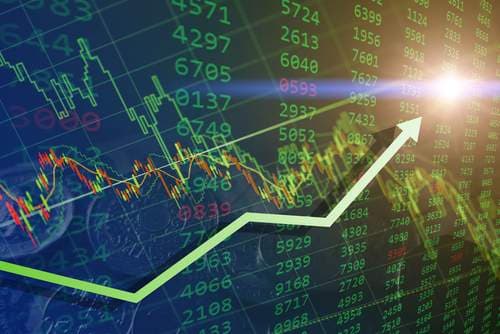Beneath the Surface
The Market’s Worst-Case Scenario: A Lost Decade
March 11, 2025 • 6 minute, 14 second read

“After 1929, so many people had been traumatized by the stock market crash that there was a lost generation.”
– Ron Chernow
March 11, 2025 — Traders often look to history to determine what’s going on in the market. From historical patterns and the current trend, they develop a narrative.
Since the start of the year, there’s been a tug-of-war between two narratives. In January and early February, the bullish narrative has won out.
Since then, that’s turned more bearish. Let’s look at what investors saw, the two narratives, and what’s likely to occur in the rest of 2025.
In January, the latest economic data kept markets from repeating 2022, and sliding into the start of a bear market.
The labor market showed some signs of strength, with unemployment declining to 4.0% in January from 4.1% in December.
While the official government data tends to get revised heavily in subsequent months, the market fell in anticipation of a hot labor market potentially juicing inflation.
Meanwhile, the inflation data for January came in pretty close to December’s data. Inflation remains above where the Federal Reserve would like it to be, but it isn’t so high that the Fed would have to raise interest rates as some fear.
But, a look at history shows that two scenarios are likely to play out this year.
On the macro level, inflation could still yet spike higher. February’s stubborn inflation data seemed to inch in that direction.
That didn’t help markets trend higher. Nor the fact that markets were priced to perfection after a 27-month rally fueled by the launch of ChatGPT.
In a way, the recent market pullback was overdue. But investors needed the right mix of news and data to justify a pullback. With rising tariff uncertainty, they got it.
So, let’s take a closer look at the two narratives playing out today.
Back to the 70s: Don’t Count Out a Second Inflationary Blip Quite Yet
The market hasn’t been a fan of this year’s labor data. To be fair, the December data was a relative blowout.
As I predicted in January, revisions in future months often change the headline data, it wouldn’t be surprising to see December’s jobs data look less attractive later in the year. Also, December is notorious for seasonal adjustments related to the holidays that may not reflect the economy’s fundamentals.
That’s now borne out, and the labor market appears to be worsening, especially with the added kick of government layoffs. The economy is still at full employment numbers, but investors are increasingly watching the trend.
For now, a strong labor market typically means strong consumer spending. However, too much spending and too high wage growth could lead to inflationary pressure.
So far, inflation remains “sticky” around 3%, well over the Federal Reserve’s target rate of 2%. While January’s data didn’t increase, February’s showed a slight increase. We can’t rule out increased inflation in the months ahead.
If we do get a resurgence of inflation, markets may follow a 1970’s style scenario, with a second wave of inflation:

For now, we’re watching this data closely. If inflation ticks higher, investors will want to shift toward commodity-related investments. That includes precious metals, such as gold and silver. It may also include bitcoin and other major cryptocurrencies.
But assets like oil and copper could also be big winners, as they also held up well during the inflationary 1970s.
However, this scenario isn’t set in stone. There’s another scenario at play right now that stands opposite this one. And 2025 may be a tug-of-war between the two narratives.
The 90’s Will Never Die: Tech Overvaluation Suggests Muted Market Returns
Since the launch of Chat GPT, stocks have been on a tear. Particularly any company that’s decided to embrace AI.
By mid-February, markets at a record high valuation. There’s an expectation that markets can “grow” into that valuation thanks to productivity improvements in AI.
If that’s true, and history is doubtful, it simply means that today’s market price may not move significantly higher in the years ahead.
Over the past year, for instance, tech giant Apple barely grew earnings. But shares surged higher, and the stock went from 30 times earnings to 40 times earnings.
Listen, Apple makes a great suite of products. But at 40 times earnings, everything has to go right for big future returns. But Apple hasn’t had a big new product in over 10 years.
They haven’t innovated. And if they hadn’t been buying back billions of dollars in shares, Apple’s earnings per share would have flatlined.
Is it similar to the 1990s tech bubble? Absolutely. The parallels are there, and obvious. By some measures, markets are even more overpriced now than in the 1990s.
If the AI revolution plays out like the internet, we could see AI technology continue to develop, but for high-flying AI startups to collapse like dotcom stocks.
That’s not to say investors should get out now. By some measures looking at AI development versus the internet, 2025 may be another big year for tech stocks, much like stock returns in 1998 and 1999.
If anything, today’s high market valuation reflects a high level of overconfidence in stocks, as seen by how quickly sentiment has changed in recent weeks as companies like Tesla Motors have slipped 50% from their recent highs.
Don’t join in the overconfidence, and look to take quick profits when AI or tech stocks in your portfolio surge higher.

Bonds Are Fighting the Fed
There’s another reason to think about shifting out of stocks in 2025: There are other assets that can offer reasonable returns from here. You don’t have to be “all in” on stocks.
That sensibility may have worked in a decade like the 2010s, when interest rates largely sat near 0%.
However, with bond yields still near their highest level in 15 years today, investors have reasonable alternatives to stocks.
In the worst-case scenario, stocks could even have a “lost decade.”
The market’s last “lost decade” was actually a 12-year period. From 1997, when the tech boom went into full bubble mode, to the 2009 lows from the housing crisis, the S&P 500 made a round-trip with zero returns.
Over that time, investors still had opportunities in tech stocks, at least the first two years, as tech languished in the 2000s.
Cyclically, the late 1990s marked a low in commodities, with assets such as oil and gold starting to take off. Real assets such as real estate also took the market lead as tech sold off. And the post-tech bubble reflation trade helped non-tech stocks mark new highs by 2007, before the financial crisis selloff.
Only a very long timeframe will tell if we’re in a lost decade. But in that scenario, investors can still get great returns as long as they know which stocks to buy and which to avoid. And to take a more tactical approach to the market and stick to paying reasonable valuations.
Regards,

Andrew Packer,
Grey Swan
P.S. While we think the market got ahead of itself, it hasn’t yet had the kind of blow-off top mania that marks the cyclical end of a market. We still see some upside ahead, but investors will want to make sure they separate the winners from the losers. Our latest research does just that.
Please send your comments to feedback@greyswanfraternity.



